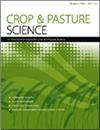Modelling spatial and temporal correlation in multi-assessment perennial crop variety selection trials using a multivariate autoregressive model
IF 1.9
4区 农林科学
Q2 AGRICULTURE, MULTIDISCIPLINARY
引用次数: 0
Abstract
ABSTRACT Context. Perennial crop variety selection trials are often conducted over several seasons or years. These field trials often exhibit spatial correlation between plots. When data from multiple assessment times are analysed, it is necessary to account for both spatial and temporal correlation. A current approach is to use linear mixed models with separable spatial and temporal residual covariance structures. A limitation of these separable models is that they assume the same spatial correlation structure for each assessment time, which may not hold in practice. Aims. This study aims to provide more flexible methods for modelling the spatio-temporal correlation in multi-assessment perennial crop data, allowing for differing spatial parameters for each time, together with modelling genetic effects over time. Methods. The paper investigates the suitability of two-directional invariant multivariate autoregressive (2DIMVAR1) models for analysis of multi-assessment perennial crop data. The analysis method is applied to persistence data from a pasture breeding trial. Key results. The multivariate autoregressive spatio-temporal residual models are a significant improvement on separable residual models under different genetic models. The paper demonstrates how to fit the models in practice using the software ASReml-R. Conclusions. A flexible modelling approach for multi-assessment perennial crop data is presented, allowing differing spatial correlation parameters for each time. The models allow investigation into genotype × time interactions, while optimally accounting for spatial and temporal correlation. Implications. The models provide improvements on current approaches and hence will result in more accurate genetic predictions in multi-assessment perennial crop variety selection trials.利用多元自回归模型对多年生作物品种选择试验的时空相关性进行建模
本文章由计算机程序翻译,如有差异,请以英文原文为准。
求助全文
约1分钟内获得全文
求助全文
来源期刊

Crop & Pasture Science
AGRICULTURE, MULTIDISCIPLINARY-
CiteScore
4.20
自引率
15.80%
发文量
111
审稿时长
3 months
期刊介绍:
Crop and Pasture Science (formerly known as Australian Journal of Agricultural Research) is an international journal publishing outcomes of strategic research in crop and pasture sciences and the sustainability of farming systems. The primary focus is broad-scale cereals, grain legumes, oilseeds and pastures. Articles are encouraged that advance understanding in plant-based agricultural systems through the use of well-defined and original aims designed to test a hypothesis, innovative and rigorous experimental design, and strong interpretation. The journal embraces experimental approaches from molecular level to whole systems, and the research must present novel findings and progress the science of agriculture.
Crop and Pasture Science is read by agricultural scientists and plant biologists, industry, administrators, policy-makers, and others with an interest in the challenges and opportunities facing world agricultural production.
Crop and Pasture Science is published with the endorsement of the Commonwealth Scientific and Industrial Research Organisation (CSIRO) and the Australian Academy of Science.
 求助内容:
求助内容: 应助结果提醒方式:
应助结果提醒方式:


